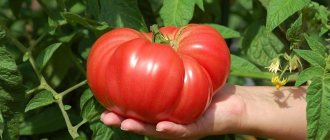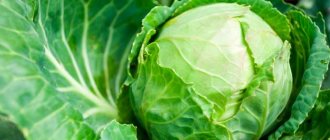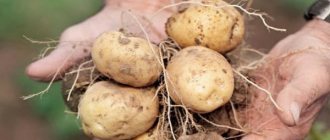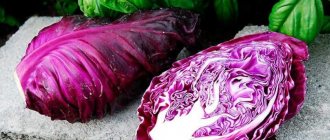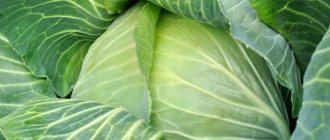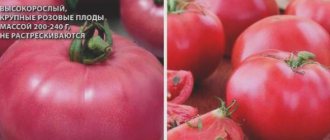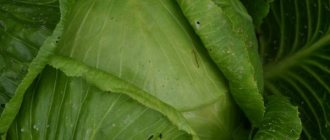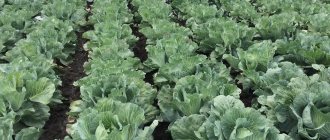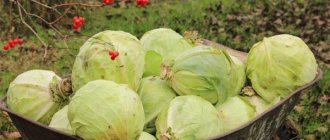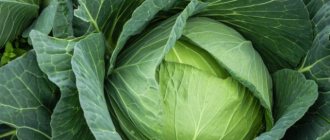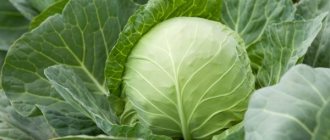Ankoma f1 cabbage is a universal hybrid variety of white cabbage that is perfectly stored and can be used for preparing any dishes. Breeders have made the plant resistant to stress and not always favorable open ground conditions, and have significantly simplified the care requirements.
| Landing location | Ripening time | View | Purpose | Origin | Maturation period | Weight |
| Open ground | Mid-late | White cabbage | Fresh, Long-term storage, Salting, Pickling, Canning, Cooking | Hybrid | 120-130 | 2,1-3 |
Beneficial features
White cabbage is native to the Mediterranean and was known back in Ancient Greece. In Kievan Rus, its descriptions are found in manuscripts of the 11th century, and it was here that sauerkraut was first used.
The Ankoma F1 cabbage variety retains all the beneficial properties of white cabbage, for which it is valued by both vegetable growers and consumers:
- the upper green leaves contain a lot of folic acid, which is involved in the synthesis of hemoglobin, and the lower, lighter leaves are useful for the prevention of atherosclerosis;
- a high concentration of ascorbic acid protects against colds in the off-season. Cabbage contains chemicals that prevent the deposition of cholesterol on the inner walls of blood vessels;
- fiber normalizes the functioning of the digestive system;
- cabbage is a natural source of vitamins U and PP, which are known for their ability to heal small ulcers on the gastric mucosa.
Compound
Vitamin C in the composition is a powerful antioxidant; it is responsible for many processes in the human body: removes toxins, helps cope with respiratory diseases. The Ankoma variety has the most stable chemical composition of the vitamin, so after fermentation or other processing, the beneficial properties of the vegetable do not disappear.
Vitamin U is a rare substance found in few raw vegetables. Late-ripening cabbage varieties have it in large quantities. Vitamin juice can heal stomach ulcers at an early stage.
Ankoma is a low-calorie vegetable; 100 g of product contains only 27 kcal. The vegetable helps with swelling and removes excess fluid from the body. Bruises and other mechanical damage can be easily removed by applying a cabbage leaf to the affected area.
Characteristic
The Ankoma variety has a flat-round shape with good density and a short stalk. Ankoma cabbage is grown in open ground and is suitable for consumption both fresh and prepared. It is excellently stored in winter and can withstand long-term transportation without losing its excellent presentation. Thanks to its well-developed root system, the Ankoma variety is resistant to dry periods. It is unpretentious to growing conditions and has good resistance to diseases, in particular fusarium. The ripening time for Ankoma cabbage is 4.0-4.5 months from the moment the seedlings are planted. With proper agricultural technology, the yield reaches 400-600 centners per hectare, and the weight of 1 head of cabbage ranges from 2 to 3 kg.
In order to plant Ankoma cabbage seedlings in open ground on time, the description of the variety recommends sowing the seeds in the middle or end of March.
Ankoma cabbage seeds are sown in peat pots, in which they can then be planted in the soil.
The best way to grow Ankoma seedlings is in solar greenhouses, which become warmer during the day and cooler at night. Natural hardening of the plants occurs, and they grow healthy and strong.
Description of the cabbage variety Coronet F1
Coronet F1 is a mid-season white cabbage hybrid.
This variety was developed by Japanese scientists from the company Sakata. The variety is included in the State Register of the Russian Federation and is recommended for cultivation in the North Caucasus region. In today's publication you will learn a detailed description of the variety, see photos and reviews from summer residents about this amazing Japanese hybrid.
Characteristic
As stated earlier in the article, CoronetF1 is a mid-season hybrid. The entire growing season of this cabbage is 110-120 days.
As for yield, Coronet is quite a productive cabbage. From 1 hectare of plantings, subject to agrotechnical rules and cultivation in favorable conditions, you can collect from 800 to 1000 centners. Of the entire harvest, the yield of marketable products is about 90-99%.
Leaf rosette of a natural type culture. The leaves are large, gray-green in color. There is a medium or strong waxy coating on the surface of the leaf blade. The sheet is not even, there is some bubbles.
Heads of cabbage weigh from 3 to 4 kg, round in shape. The outer part is grey-green, the inner part is white, with a green central part. Heads of cabbage almost never crack. Also, they set well at unsatisfactory humidity and high temperatures. Under short-term unfavorable conditions, no serious damage to the crop is observed.
The hybrid has a fairly good immunity, protecting it from such misfortunes as:
- Fusarium.
- Internal necrosis of leaves.
- Damage to the root system.
Cabbage is stored very well not only in the cellar (up to 9 months), but also has a high preservation rate on the root.
Advantages and disadvantages of a hybrid
Coronet F1 has a number of advantages, thanks to which it is in great demand not only among summer residents, but also among consumers on the market. The main advantages include:
- Stable yield.
- High yields.
- High percentage of commercial output.
- Protection against most cabbage diseases.
- The versatility of heads of cabbage. They can be used fresh, stored, fermented, and frozen.
- Heads of cabbage have a high commercial value. Due to their high density, they are easily transported over long distances.
- The heads are resistant to cracking.
- The variety is not afraid of short-term droughts.
However, it is worth noting some minor disadvantages. In particular, these include:
- Like any other cabbage variety, Coronet is demanding when it comes to watering. It tolerates short-term droughts, but without good watering a high-quality harvest cannot be obtained.
- Damage by insects is possible, since the vegetable is not completely protected from them.
How to care for a hybrid
Caring for a Japanese hybrid consists of loosening the soil, hilling, clearing the area of weeds, watering, fertilizing and pest control. At first glance, this list seems large, but it only seems so. During hilling, weeds are removed and the soil is loosened. During loosening, weeds are also removed.
As noted earlier, the main problem is parasites, in particular aphids and cabbage cutworms, which love to feast on the Japanese variety. To control pests you will have to purchase special insecticides.
We recommend reading: Description of the cabbage variety Bronko F1
Watering is stopped 2 weeks before harvest. This will provide protection against cracking of the heads of cabbage, and will also increase the shelf life of the crop.
Soil preparation
The area for planting Ankoma seedlings should be sufficiently illuminated. With a lack of light, large leaves are formed, producing a loose head of cabbage. Cabbage seedlings are planted according to a 0.7x0.7 m pattern. Too close a location will negatively affect the yield. The soil should not be very loose and fairly fertile, with an acidity close to neutral. Cabbage Ankoma F1 grows well on loam. To prepare the soil in the spring, you need to dig it up with compost and mineral fertilizers.
Important! In areas where groundwater comes close to the surface, it is recommended to make high beds - up to 20 cm.
Advantages and disadvantages
Among the main advantages of Ankom are:
- high and stable yield;
- good taste (sweetness, juiciness, no bitterness);
- frost resistance and adaptation to adverse weather conditions;
- storage duration: the harvest remains until the beginning of spring without loss of taste;
- transportability of heads of cabbage;
- immunity to fungal diseases;
- ease of care.
No obvious deficiencies were identified during the variety testing.
Differences from other varieties and hybrids
This variety of cabbage is recommended to be grown in seedlings. Her harvest ripens at the same time, the heads of cabbage are identical in shape and weight.
Planting seedlings
To transplant Ankom seedlings into open ground, you need to choose a cloudy day; you can also plant it in the early morning or evening. You should not plant Ankom cabbage in cool weather, as it may shoot arrows. In order for seedlings to grow quickly, you need to plant them correctly:
- Plants need to be buried in the soil up to the first leaf;
- The soil around each stem should be well compacted;
- all plants should be watered immediately after planting and the next day;
- For better adaptation of the Ankoma variety, after transplanting, shade the seedlings for 2-3 days.
To disinfect already planted seedlings you need:
- sprinkle it with wood ash - this treatment should be carried out after rains;
- Regularly water the plants with a weak solution of potassium permanganate.
Important! A month after planting, Ankom cabbage seedlings are earthed up. This procedure must be repeated a second time after 2 weeks.
Many gardeners use the technology of growing cabbage without seedlings. If you sow seeds directly into the soil, its growing season is shortened, and the root system becomes more powerful. The rules of care are the same as for the seedling method.
Growing rules
In the southern regions, gardeners quite often use the seedless method, sowing seeds directly into open ground and covering the plants only at the initial stage of their growth. The hybrid's high resistance to adverse weather conditions allows this to be done. However, the main method of growing Ankoma F1 cabbage in most other areas is from seedlings.
Planting seedlings
Planting Ankoman cabbage seeds and seedlings is carried out from February to April, depending on the region of future cultivation. It is advisable to use individual peat pots for planting seeds. You can also grow seedlings in greenhouses under film cover. The seeds germinate 2-3 weeks after planting. The seedlings will be ready for transplanting into open ground when the plants have formed 2-3 full-fledged leaves.
Seedlings can also be grown in groups in large, wide containers. In this case, it will need picking - planting for growing before planting in open ground. This procedure is stressful for the plant, so after it is carried out, the seedlings are fed with a solution of complex mineral fertilizers to speed up adaptation.
Transplantation into open ground
To achieve good yields, the soil for planting cabbage of this variety is prepared in the fall. It needs to be dug up, weeds removed, and organic fertilizers such as compost added. The area where cabbage is grown should be well lit. The soil is preferably loamy, with a neutral or similar acidity level.
Grown seedlings are planted in open ground in May or early June. This should be done in cloudy weather, in the morning or evening. An individual hole is prepared for each pot of seedlings. Between adjacent plantings, it is imperative to maintain an interval of at least 40-50 cm so that the grown plants do not compete with each other. The seedlings are buried in the soil up to the first leaf, then sprinkled with earth. After this, be sure to water abundantly.
Important! In the first days, the plants are watered with a weak solution of potassium permanganate and sprinkled with wood ash for disinfection.
Aftercare
The most important measures for caring for cabbage plantings are regular watering and loosening the soil. You need to water the seedlings at least 3 times a week, it is preferable to do this in fractions, in the morning and in the evening. Despite the fact that the hybrid can withstand even severe drought, a lack of water significantly impairs the taste and also increases the hardness of the leaves. Before the head is formed, at least 1 bucket of water is added to each bush, then its consumption is gradually reduced, and a month before harvesting, watering is stopped completely.
Important! Between waterings, it is imperative to loosen the soil to ensure air access to the root system. To increase productivity, it is recommended to fertilize cabbage several times during the ripening period.
To do this, it is best to use mullein infusion diluted with water in a ratio of 1:10. Fertilizing is done using the root method. Feeding seedlings at an early stage with an aqueous solution of iodine tincture gives good results.
To increase productivity, it is recommended to fertilize cabbage several times during the ripening period. To do this, it is best to use mullein infusion diluted with water in a ratio of 1:10. Fertilizing is done using the root method. Feeding seedlings at an early stage with an aqueous solution of iodine tincture gives good results.
Watering mode
For a month after planting the seedlings, Ankoma cabbage should be watered 2 times a week, and then once a week. During the formation of a rosette of leaves, cabbage's need for water increases. Before the head forms, the water requirement is quite large - about 1.5-2 buckets. Then it gradually decreases. If Ankoma cabbage is going to be stored after harvesting, you need to stop watering about a month in advance.
The following watering regime is more effective for optimal development of Ankoma cabbage:
- It is better to carry it out 2 times a day - morning and evening;
- It is better to water more often and less - then the roots will be better supplied with oxygen and nutrition, stimulating the rapid growth of the head of cabbage;
- after each watering, the soil around the plants must be loosened to ensure its breathability;
- The watering regime must be adjusted taking into account the weather.
Watering must be calculated very carefully - too high humidity threatens the heads of cabbage cracking. Lack of water is also dangerous:
- development of forks slows down;
- Leaves that are too hard are formed.
Ankoma F1 cabbage seeds b/c late 120-130 days. 2.5-4 kg approx. (Rijk Zwaan)
Order by phone
- +38 ( 050 ) 699-12-64
- +38 ( 066 ) 827-50-68
- +38 ( 066 ) 827-50-68
- +38 ( 067 ) 771-68-61
- +38 ( 068 ) 347-43-44
- +38 ( 097 ) 058-95-54
- +38 ( 093 ) 348-47-82
- +38 ( 063 ) 238-93-97
Important
No minimum order amount! But prepayments are required:
- for orders up to 200 UAH;
- for goods to order - 100% prepayment;
- Each order contains a gift.
Every day:
For order values over 2,500 UAH and weight up to 500 grams, delivery is free (from 12/15/2018)
Discounts
When ordering for 3,000 UAH - 3% discount, 5,000 UAH - 5% discount, 10,000 - 10% discount
Discounts cannot be combined!
Receive gifts by ordering online
Each customer who places an order online (by registering in the store and making purchases through the basket) receives a magazine, a package of seeds and a calendar as a gift (included in the order from September to January).
Contacts for placing an order in the ATO zone
We accept orders for vegetable seeds from the ATO zone
Telephone: 066 061 04 03
White cabbage Ankoma F1 – description:
Ankoma F1 is a late (120 - 135 days) hybrid of white cabbage, which is intended for long-term storage, processing and for use in the fresh market.
The average weight of the head is from 3 to 4 kilograms. The head is flat-rounded, dense, light green in color.
It tolerates drought well, is resistant to diseases, as well as fusarium.
Cabbage Ankoma F1 is a participant in the following ratings and reviews in Seed Supermarket magazines:
- review of middle and late cabbages for fresh consumption, No. 5 “Spring 2016”, p. 18.
- review of the best cabbages for pickling, No. 5 “Spring 2016”, p. 21.
- review of the best cabbages for storage, No. 5 “Spring 2016”, p. 23.
- review of popular mid-late and late cabbages, No. 2 “Spring sowing 2015”, p. 14.
Attention! The manufacturer reserves the right to change the packaging design, color and availability of seed treatment
Pest Control
Despite the resistance of Ankoma cabbage to pests, preventive treatment of plants against the most dangerous diseases is necessary - blackleg, downy mildew, aphids and others. Treatment with copper sulfate solution is effective against fungal diseases. Gardeners also use proven folk remedies, such as infusions of garlic, nettle, and dandelion.
Reviews
Among gardeners, the Ankoma cabbage variety is very popular, as evidenced by numerous letters from summer residents.
Knopkina Ekaterina, 52 years old, Saratov
Last year I planted Ankoma for the first time, as a test. I really liked the variety - the heads are dense, light green, juicy, crispy. Stored well in winter. Satisfied with the taste and keeping quality.
Danilov Prokhor, 69 years old, Nizhny Novgorod
I have been growing Ankoma cabbage for several years now. I like its ease of care, high yield, excellent taste. We always ferment it for the winter, but even fresh it is well preserved without losing its juiciness. I recommend the Ankoma variety to everyone I know.
Rasteryaev Leonid, 80 years old, Volgograd region
Of all the late varieties I dealt with, I liked the Ankoma variety the most. It is characterized by an excellent combination of taste and simplicity in agricultural technology. Resistant to diseases. During storage it does not lose its juiciness and taste.
Zyuzina Agrippina, 63 years old, Stavropol region
A wonderful variety is Ancona. I grow it without seedlings - I plant it with seeds in April. The rules of care are very simple - you just need to water it on time, sometimes feed it and carry out preventive spraying. I really like the taste of cabbage; it also works great in pickles.
Description of the best views
Ammon f1
Late-ripening hybrid, productive, long-term storage. Heads of cabbage are well preserved for 12 months. Ripening period is 140 days. The leaves are not large, raised, gray-green, bubbly with a waxy coating and wavy edges.
The weight of the head of cabbage will depend on the planting density and can reach 6 kg, dense, with an even build. The plant is powerful with medium outer and inner stalks. The plant is resistant to thrips and fusiaria.
Ankoma
Late-ripening variety, with a ripening period of 4 months from the moment of planting seedlings in open ground. The forks are flat-round, dense with a short stalk. Cabbage is suitable for pickling and pickling. It is well transported without losing its presentation and can be stored for a long time in winter.
The root system of the hybrid is very powerful, so the hybrid can withstand dry periods. The high-yielding variety yields 600 centners per hectare, with proper agricultural technology. The weight of one head of cabbage reaches three kilograms.
Lennox
A late-ripening hybrid that is grown both without seedlings and in seedlings. The head is dense with thin leaves and an attractive appearance. A small poker, and the weight of one fork is 5 kg. A distinctive feature of this variety is that its leaves contain a high concentration of ascorbic acid and sugar.
The hybrid has a long shelf life, so it is grown by farms for sale. The variety is universal, suitable for winter harvesting and for fresh consumption. The root system is powerful, thanks to which the plant tolerates drought.
Important: Can be stored for 8 months from the date of harvest, while up to 10 kg of heads of excellent quality can be collected per square meter
Favorite
Mid-late hybrid, growing season 150 days. Horizontal rosette of light green leaves. The stump is not big. The head of cabbage is dense, flat-round in shape and white-yellow when cut. The weight of the fork reaches three kilograms. Upon reaching marketable yield, you can harvest 630 c/ha. The variety is resistant to fusarium.
Redbor
Redbor kale f1 is a late-ripening variety with dark purple curly leaves, suitable for growing in northern conditions. The bush grows 80 cm tall and weighs from 200 to 700 grams. The hybrid is frost-resistant, can withstand down to –18 degrees. It is worth noting that after frost, cabbage becomes very tasty, juicy and soft.
Watch a video about Redbor kale:
Stone head
White-headed, late-ripening variety with round, dense heads of cabbage. The weight of one fork can reach four kilograms. The leaves in the fork fit tightly to each other without forming voids. Cabbage is white in cut and resistant to cracking. The hybrid can be stored for a long time without losing its taste, which only improves during storage. If you plant cabbage as seedlings, the harvest can be harvested on day 120 - with seeds in the ground, after 160 days.
Galaxy
A late-ripening, easy-to-care hybrid, with a ripening period of 135 days after planting the seedlings. The plant is erect, powerful, with a round head weighing 6 kg. It is worth noting that the variety produces a good harvest even on poor soils, and is resistant to cracking. It can be stored for a very long time, up to 12 months. The hybrid is high-yielding, stress-resistant, and easily transportable.
